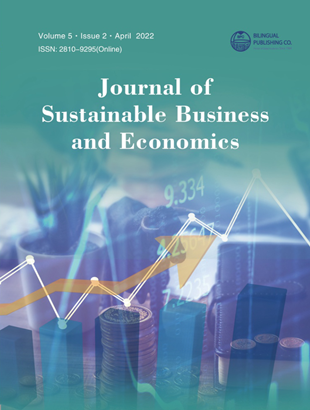-
255
-
176
-
158
-
128
-
125
Analysis and Investigation on the Core Competitiveness of Textile and Underwear Industry in the Mainland and Taiwan of China and Myanmar under the Global Value Chain
DOI:
https://doi.org/10.30564/jsbe.v5i2.7Abstract
All the way in the “area”, “comprehensive economic partnership agreement” (RCEP), Association of Southeast Asian Nations (ASEAN) free trade area, the main economic corridor construction under the background of success, the mainland and Taiwan of China and southeast Asia has established the important relations of cooperation, industries are beginning to consider labor costs, raw materials, using the regional to invest policy and market comparative advantage. This paper starts from the investigation of Topline’s core competitiveness in China and Myanmar, and focuses on the analysis of lingerie industry in China and Myanmar, and the analysis of women’s underwear industry from the perspective of global value chain (GVC). Through the data analysis of the questionnaire survey, this paper summarizes the problems existing in the current situation of the industry, uses the intermediary analysis to analyze the correlation between the two variables, reveals the role of the core competitiveness of enterprises, and uses the GVC theory to analyze the problems existing in the industry of enterprises and their causes. According to relevant theories, the optimization path of enterprise value chain is put forward.
Keywords:
Global value chain analysis; The questionnaire survey; Textile industry; Southeast Asia; Intermediary roleReferences
[1] Wu, W.T., Chan, C.H., Yen, H.T., 2013. Changes the Firm’s Core Competences from OEM to OBM-Case Study of FPG International Co., Ltd. Journal of Innovation research and Development. 9(1), 39-49. DOI: https://doi.org/10.30080/JIRD
[2] Verhoef, P.C., Broekhuizen, T., Bart, Y., et al., 2021. Digital transformation: A multidisciplinary reflection and research agenda. (122), 889-901. DOI: https://doi.org/10.1016/j.jbusres.2019.09.022
[3] Lin, P.X. Research on strategic innovation issues in textile and apparel industry. Taiwan University. DOI: https://doi.org/10.6342/NTU202103997
[4] Shi, H.C., 2018. The Taiwan regional investment layout in response to changing business environment. Economic Perspective. (176), 99-104. DOI: https://doi.org/10.30071/EOB
[5] Hsieh, C.H., 2015. Endogenous Two-sided Heterogeneity, Own-Brand Strategies, and Government Policy. Academia Economic Papers. 43(4), 447-479. DOI: https://doi.org/10.29628/AEP
[6] Zhu, W.L., Mou, J., Benyoucef, M., 2019. Exploring purchase intention in cross-border e-commerce: a three stage model. Journal of Retailing and Consumer Services. 51. DOI: https://doi.org/10.1016/j.jretconser.2019.07.004
[7] Pituch, K.A., Stapleton, L.M., 2008. The Performance of Methods to Test Upper-Level Mediation in the Presence of Nonnormal Data. Multivariate Behavioral Research. 43(2), 237-267. DOI: https://doi.org/10.1080/00273170802034844
[8] Tsai, M.Sh., Chang, K.I., 2013. The Comparison between Labor Cost and Market Location Choice in Outward Fdi: Evidence from Taiwan’s Main Manufacturing Industry. Taiwan Economic Forecast and Policy. 43(02), 83-122. DOI: https://doi.org/10.29629/TEFP
[9] Chao, Y.Sh., Chiu, S.Ch., Pai, T.M., 2020. The Comparative Study on the investment Performance and Systematic Risk in China after the COVID-19 Pandemic period-Taiwan loT Corporates for Example. Global Management and Economics. 16(2), 81-98. DOI: https://doi.org/10.6565/JGME.202012_16(2).0006
[10] Silva, E.S., Hassani, H., Madsen, D.I., 2020. Big Data in fashion: transforming the retail sector. Journal of Business Strategy. 41(04), 21-27. DOI: https://doi.org/10.1108/JBS-04-2019-0062
[11] Gomez-Herrera, E., Martens, B., Turlea, G., 2014. The drivers and impediments for cross-border e-commerce in the EU. Information Economics and Policy. 28(01), 83-96. DOI: https://doi.org/10.1016/j.infoecopol.2014.05.002
[12] Hwangbo, H., Kim, Y.S., Cha, K.J., 2018. Recommendation system development for fashion retail e-commerce. Electronic Commerce Research and Applications. (28), 94-101. DOI: https://doi.org/10.1016/j.elerap.2018.01.012
[13] Aksoy, A., Ozturk, N., 2015. Design of an intelligent decision support system for global outsourcing decisions in the apparel industry. Journal of the Textile Institute Proceedings & Abstracts. 107(10), 1322- 1335. DOI: https://doi.org/10.1080/00405000.2015.1103985
[14] Qi, X., Chan, J.H., Hu, J., et al., 2020. Motivations for selecting cross-border e-commerce as a foreign market entry mode. Industrial Marketing Management. 89. DOI: https://doi.org/10.1016/j.indmarman.2020.01.009
[15] Tsou, Y., Chen, H.G., 2019. Research on the Impact of Global Value Chain Reorganization on Taiwan’s Industrial Structure and Countermeasures. Management Practice and Theory Research. 13(1), 35-68. DOI: https://doi.org/10.29916/JMPP
[16] Chu, C.C., Sun, B., Wen, Zh.J., et al., 2022. Economic cycle synergy between China and Southeast Asian countries. Statistics & Information Forum. pp. 1-14. http://kns.cnki.net/kcms/detail/61.1421.C.20220412.1549.004.html.
[17] Inomata, S., 2018. Analytical frameworks for global value chains: An overview. Social Science Electronic Publishing. https://www.wto.org/english/res_e/booksp_e/gvcs_report_2017_chapter1.pdf
Downloads
How to Cite
Issue
Article Type
License
Copyright © 2022 Haichao Wu, Lan Luo, Yingshan Zeng, Rudan Wang, Yue Zhang, Chien Chi Chu

This is an open access article under the Creative Commons Attribution 4.0 International License.




 Haichao Wu
Haichao Wu

